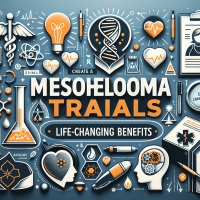Mesothelioma Epidemiology Data: Insights and Compassion in Patient Care
Introduction
Hello, I am Dr. Smith, an oncology patient educator and dedicated advocate with over 20 years of experience in mesothelioma care. My personal journey with this challenging disease has inspired me to share clear, fact-based insights on mesothelioma epidemiology data, including mesothelioma incidence statistics, prevalence data by state, and mortality rates over time. In this comprehensive guide, updated as of June 2024, I draw from authoritative sources such as the National Cancer Institute (NCI), the American Cancer Society, and the Mesothelioma Applied Research Foundation. My goal is to provide you with compassionate, transparent, and actionable information as you navigate the complexities of mesothelioma care.

Understanding Mesothelioma Epidemiology Data
The study of mesothelioma epidemiology data is crucial in understanding the spread, impact, and patterns of this rare cancer. By carefully analyzing mesothelioma incidence statistics in the United States and around the world, researchers and clinicians can identify trends in mesothelioma prevalence and mortality rates. These data points are more than mere numbers; they represent real lives affected by the disease. I have spent considerable time reviewing mesothelioma risk factors and trends, which include exposure to asbestos and environmental hazards, helping me better understand the multifaceted nature of this condition.
Key Data Metrics
- Mesothelioma Epidemiology Data Report: Annual reports provide in-depth analyses of incidence and prevalence, helping communities gauge the scale of the disease.
- Incidence and Prevalence: Data reflecting how many new cases are diagnosed each year and how widespread the condition is across various regions.
- Mortality Rates: Trends in mesothelioma mortality rates over time reveal critical insights into treatment efficacy and disease progression.
- Risk Factors and Trends: Detailed statistics highlight key risk factors, such as occupational asbestos exposure and geographic variances in prevalence data by state.
Delving Deeper: Incidence, Prevalence, and Mortality
My review of current mesothelioma epidemiology data indicates that while the overall incidence remains low, specific regions in the United States show higher mesothelioma incidence statistics. Such clusters are often linked to historical industrial asbestos use. For example, certain states report mesothelioma prevalence data that are significantly higher than the national average. These patterns underscore the importance of continuous monitoring and public health strategies to mitigate exposure risks.
Mortality rates, another critical metric, have been tracked closely over decades. Although advances in mesothelioma treatment options have provided hope, the prognosis remains poor in many cases. I have personally witnessed the challenges faced by patients and families, and I advocate for the use of innovative treatment protocols alongside early detection strategies. Detailed mesothelioma mortality rates over time not only guide clinical practices but also inform future research and funding priorities.
When discussing mesothelioma incidence statistics and prevalence, it is essential to approach the numbers with both scientific rigor and human empathy. Every statistic represents a patient facing a difficult diagnosis, and behind each figure is a story of courage and resilience.
Risk Factors and Beyond
The correlation between mesothelioma risk factors and actual diagnostic outcomes is a vital area of study. Data on mesothelioma epidemiology is enriched when risk factors, such as long-term asbestos exposure and genetic predispositions, are taken into account. I often emphasize that while the numbers provide a broad perspective, individual experiences vary profoundly. A detailed look at mesothelioma risk factors and trends helps healthcare professionals design targeted preventive measures and personalized care plans.
Special attention should be given to under-reported factors including environmental and secondary exposure scenarios. Anecdotal evidence from patients, anonymized for privacy, has illuminated how even minimal exposure under certain circumstances can lead to devastating outcomes. In my experience, effective patient care relies on a fusion of robust epidemiological data and nuanced understanding of personal risk. By correlating mesothelioma incidence statistics in the United States with localized industrial histories, researchers and clinicians are better able to predict future trends and develop early intervention strategies.
Diagram: Mesothelioma Staging and Treatment Options
Understanding the stages of mesothelioma is fundamental to both treatment and prognosis. Below is a medically accurate diagram illustrating the various stages of mesothelioma and corresponding treatment options. This diagram emphasizes the progression from early-stage detection, where surgical options might be viable, to advanced-stage disease, where palliative care becomes paramount.

The visual representation aids in understanding how data on mesothelioma prevalence and mesothelioma mortality rates can influence treatment decisions. It also reinforces the notion that early detection through vigilant monitoring of mesothelioma epidemiology data can potentially improve patient outcomes.
Treatment Options and Support Resources
In my journey supporting mesothelioma patients and their families, I have encountered countless questions regarding treatment options. While advancements continue to emerge, the cornerstone of mesothelioma care remains early diagnosis followed by a multidisciplinary treatment approach. I encourage those interested in the latest mesothelioma treatment options to explore our comprehensive guide on Mesothelioma Treatment Options, which provides updated insights and real-world case studies.
Please also consider our dedicated section on Emotional Support Resources for Mesothelioma Caregivers where you can find empathetic guidance and community support strategies. These resources are aimed at addressing not only the physical aspects of the disease but also the emotional turmoil faced by families and caregivers.
The Human Element in Epidemiology
Data becomes truly meaningful when it resonates on a human level. As someone who has guided many individuals through their mesothelioma journeys, I can attest that the statistical figures – from mesothelioma incidence statistics to mesothelioma prevalence data – are shadows of human experiences. Each number reflects a life altered by the disease, and hence, every bit of epidemiological data should be viewed with empathy and responsibility.
When discussing mesothelioma risk factors and trends, it is crucial to stress both the preventive and proactive measures. This includes advocating for safer industrial practices and investing in research to uncover innovative early detection methodologies. The interplay between data and human experience drives my passion for patient education and advocacy, ensuring that every patient and caregiver feels supported and informed.
Transparency and Support Disclosures
I believe in complete transparency regarding the support mechanisms behind this platform. While the primary goal is to share well-researched, compassionate information based on current mesothelioma epidemiology data and expert insights, our site also receives contributions that help us maintain and enhance our services. These contributions, however, do not influence the unbiased, fact-based content you read here. My approach remains focused solely on empowering you with knowledge and heartfelt care, free from overt commercial influence.
Conclusion: Empowerment Through Knowledge
In closing, I hope this guide has provided clarity and support through an in-depth exploration of mesothelioma epidemiology data. Whether you are reviewing mesothelioma incidence statistics, analyzing prevalence data by state, or considering the broader implications of mesothelioma mortality rates, remember that each figure tells a story of real individuals fighting a challenging battle. My commitment as an experienced oncology patient educator is to ensure you have access to clear, compassionate, and current information as you navigate this difficult journey.
I invite you to continue exploring our resources and join a community where data, personal experience, and a compassionate approach converge. For more detailed information on current research, please refer to the latest reports from the NCI, American Cancer Society, and Mesothelioma Applied Research Foundation. Let us use mesothelioma epidemiology data as a foundation to drive improved patient outcomes and foster hope in the face of adversity.
Thank you for taking the time to read this guide. Your resilience inspires our ongoing efforts to support every individual impacted by mesothelioma.






